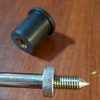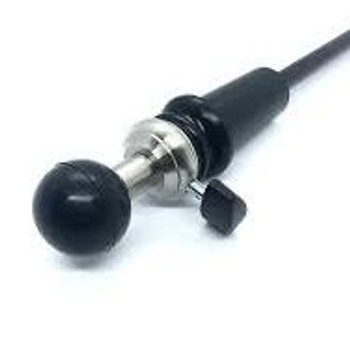Screw-On Heavy Duty Rubber Endpin Foot
We ship worldwide! (Read this)
- Small Accessory:
- This item ships FREE (USA) in a cart totaling $100 or more
Description
If you have an endpin with a threaded tip, this is a replacement for your original rubber cap (that might have been lost, worn out, damaged, or otherwise rendered unusable or ineffective.)
This little foor/cover/cap - just over 1" in surface diameter at the bottom - is the cure to dreaded "spouse comments about holes in carpet" as well as dirty looks when you spike your bass into somebody's wooden floor. It also will help avoid having your endpin skid across smooth surfaces. Extremely tough and long lasting. Made with high quality rubber.
While this endpin foot is robust, nothing is permanent; it is considered a "wear item" and will probably eventually need to be replaced once significantly worn.
THERE IS NO "STANDARD" ENDPIN SIZE. You MUST measure your endpin threads to determine whether one of these rubber tips will fit your threaded endpin.
This endpin tip has threads, and they must match the threads on your endpin exactly. If your endpin has different measurements than we've provided here, do not buy this product, it will not work with your endpin. Size matters!
To save you some time, this will not fit the stock (bare steel) Kay/Engelhardt endpin, which is 1/2" and does not have threads on it.
How to measure:
The threads that are on this endpin cover are specified as either M10-1.5 (Metric) or M08-1.25 (Metric). What that means is that the threads are on a 10mm (or 8mm) post, and the distance between each thread is 1.5 millimeters (or 1.25 millimeters). Both are common sizes, usually found on 10mm diameter endpins, and there are a couple ways to confirm that's what you have:
-
- (BEST) Take the old threaded cover (and it's just worn out/split/etc.) and make a quick trip to the hardware or home improvement store (ACE, Home Depot, Lowe's, etc.) Most of them have a "board," or a chain of various sized test bolts and nuts, that allows you to test fit a screw or nut to find out what the thread size is. (Such a "chain" is shown in the photos, above - it's the black collar that is screwed into the endpin cover.) Test-fit your endpin cover into the tester, and if it fits properly onto the threaded post marked as "M10-1.5," you'll be CERTAIN that you have the right measurement. If you don't have the old foot, you can take the whole endpin out of the bass and bring that instead.
- (PRETTY GOOD) Use a caliper to measure the diameter of the rod at the threads. If it's 10mm (or really close), measure the distance between two of the threads, using a millimeter ruler. If that measurement falls between 1mm and 2mm, then you can be fairly confident that the 10x1.5 is the right size. Ditto if the hole is about 8mm, and the measurement between FOUR threads is about 5mm; the 8x1.25 is probably your size.
- (NOT AS ACCURATE) just for the 10x1.5 version: Take a look at the photo above; the one where I've taken a closeup photo of the endpin threads next to the cover, for reference. Eyeball it as best you can. If you're not so good at spatial comparisons, though, this method has failure written all over it.
- (BEST) Take the old threaded cover (and it's just worn out/split/etc.) and make a quick trip to the hardware or home improvement store (ACE, Home Depot, Lowe's, etc.) Most of them have a "board," or a chain of various sized test bolts and nuts, that allows you to test fit a screw or nut to find out what the thread size is. (Such a "chain" is shown in the photos, above - it's the black collar that is screwed into the endpin cover.) Test-fit your endpin cover into the tester, and if it fits properly onto the threaded post marked as "M10-1.5," you'll be CERTAIN that you have the right measurement. If you don't have the old foot, you can take the whole endpin out of the bass and bring that instead.
What if, after all that, I buy it and it doesn't fit?
We've provided you as much information as possible to ensure that it's the right fit before you buy. This is a small, low-cost item, and after deducting the costs of shipping, it will probably make returning this for refund or credit utterly pointless, for both of us. So this item is an exception to our normal return policy - we do not accept returns on this item. So please, measure before you order, so that you can be confident that it will be the right option for you. I guess what I'm saying, is, don't "screw" it up!
Dimensions
- Ball Diameter: Approximately 1 3/8"
- Threads in sleeve:
- Metric M10-1.5 (10mm post with 1.5mm between threads)
- Metric M8-1.25 (8mm post with 1.25mm between threads)
Additional Tip
- If you never "spike in" on the stage, and rarely (if ever) intend to remove the cover (like most of us), I suggest getting a small tube of "Thread Lock" at the hardware/home improvement store. Get the "non-permanent" type -- the permanent type is basically superglue. Putting a drop of it on the threads before you put the rubber foot on will hold it fast and prevent loss (and annoying vibrations!) If you later find that you must remove the foot, the non-permanent threadlock will allow you to use a bit of force to break the bond and unscrew it. (With the permanent kind, it's on for good!)
1 Review
-
Endpin Foot Exact match
Measured mine as suggested, the 10mm worked and was an exact match of the one that came on my bass, easy to replace and better than the cheap slip on ones that slide. Thanks for getting it here in half the promised shipping time.















